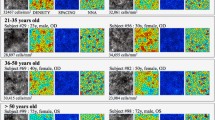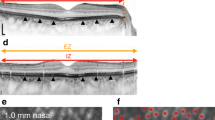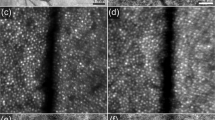Abstract
Purpose
To report on images of the human photoreceptor mosaic acquired in vivo with a newly developed, compact adaptive optics (AO) fundus camera.
Methods
The photoreceptors of two normal subjects and a patient with macular dystrophy were examined by using an AO fundus camera equipped with a liquid crystal phase modulator. In the eye with macular dystrophy, the fixation point in the AO images was identified using scanning laser ophthalmoscope (SLO) microperimetric image superimposed on a color fundus photograph.
Results
Photoreceptor cells were detected as bright dots approximately 4 μm in diameter in normal subjects. In the eye with macular dystrophy, the fixation point was located within the bull’s eye lesion and uniform small whitish spots with irregular patchiness were observed in the AO images of this area. The distance between the small spots was 3–4 μm. In other parts of the bull’s eye retinal lesion, the whitish spots were larger and of different sizes.
Conclusions
The photoreceptor mosaic could be identified in photographs of eyes of normal subjects and an eye with macular dystrophy in vivo by an AO fundus camera. In the eye with macular dystrophy, a relatively uniform photoreceptor mosaic was observed around the fixation point, whereas presumed debris of photoreceptor degradation was observed in the other bull’s eye retinal lesion.
Similar content being viewed by others
References
Liang J, Williams DR, Miller DT. Supernormal vision and high-resolution retinal imaging through adaptive optics. J Opt Soc Am A 1997;14:2884–2892.
Roorda A, Williams DR. The arrangement of the three cone classes in the living human eye. Nature 1999;397:520–522.
Roorda A, Romero-Borja F, Donnelly WJ III, et al. Adaptive optics scanning laser ophthalmoscopy. Opt Express 2002;10:405–412.
Hermann B, Fernandez EJ, Unterhuber A, et al. Adaptive-optics ultrahigh-resolution optical coherence tomography. Opt Lett 2004;29:2142–2144.
Doble N, Yoon G, Chen L, et al. Use of a microelectromechanical mirror for adaptive optics in the human eye. Opt Lett 2002;27:1537–1539.
Roorda A, Metha AB, Lennie P, Williams DR. Packing arrangement of the three cone classes in primate retina. Vision Res 2001;41:1291–1306.
Wolfing JI, Chung M, Carroll J, et al. High-resolution retinal imaging of cone-rod dystrophy. Ophthalmology 2006;113:1014–1019.
Choi SS, Doble N, Hardy JL, et al. In vivo imaging of the photoreceptor mosaic in retinal dystrophies and correlations with visual function. Invest Ophthalmol Vis Sci 2006;47:2080–2092.
Kitaguchi Y, Bessho K, Yamaguchi T, et al. In vivo measurements of cone photoreceptor spacing in myopic eyes from images obtained by an adaptive optics fundus camera. Jpn J Ophthalmol 2007;51:456–461.
Bennett AG, Rudnicka AR, Edgar DF. Improvements on Littmann’s method of determining the size of retinal features by fundus photography. Graefes Arch Clin Exp Ophthalmol 1994;232:361–367.
Oyagi T, Fujikado T, Hosohata J, et al. Foveal sensitivity and fixation stability before and after macular translocation with 360-degree retinotomy. Retina 2004;24:548–555.
Curcio CA, Sloan KR, Kalina RE, Hendrickson AE. Human photoreceptor topography. J Comp Neurol 1990;292:497–523.
Miller DT, Williams DR, Morris GM, Liang J. Images of cone photoreceptors in the living human eye. Vision Res 1996;36:1067–1079.
Pircher M, Baumann B, Gotzinger E, Hitzenberger CK. Retinal cone mosaic imaged with transverse scanning optical coherence tomography. Opt Lett 2006;31:1821–1823.
Zawadzki RJ, Choi SS, Jones SM, et al. Adaptive optics-optical coherence tomography: optimizing visualization of microscopic retinal structures in three dimensions. J Opt Soc Am A Opt Image Sci Vis 2007;24:1373–1383.
Ojima Y, Hangai M, Sasahara M, et al. Three-dimensional imaging of the foveal photoreceptor layer in central serous chorioretinopathy using high-speed optical coherence tomography. Ophthalmology 2007;114:2197–2207.
Author information
Authors and Affiliations
Corresponding author
About this article
Cite this article
Bessho, K., Fujikado, T., Mihashi, T. et al. Photoreceptor images of normal eyes and of eyes with macular dystrophy obtained in vivo with an adaptive optics fundus camera. Jpn J Ophthalmol 52, 380–385 (2008). https://doi.org/10.1007/s10384-008-0575-1
Received:
Accepted:
Published:
Issue Date:
DOI: https://doi.org/10.1007/s10384-008-0575-1




